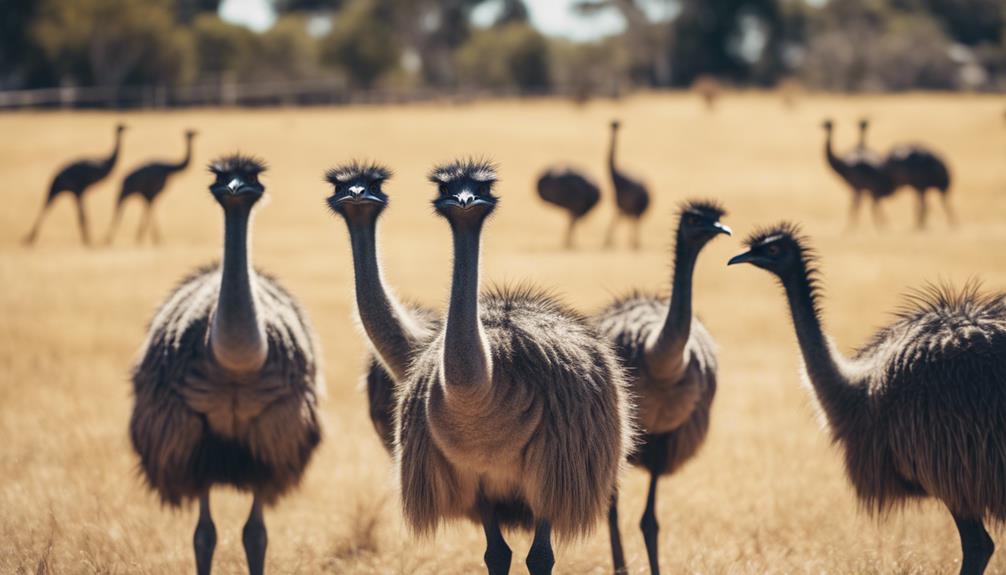
As you reflect on the intricate dance between emus and humans, consider the unspoken language that binds these two species together. The dynamics of their interactions reveal a tapestry woven with threads of respect, curiosity, and adaptation. From the vast Australian outback to the bustling urban landscapes, the story of emus and humans unfolds in unexpected ways, echoing a narrative that begs exploration. How do these feathered giants navigate the complexities of our shared spaces, and what lessons can we glean from their silent conversations?
Key Takeaways
- Emus symbolize resilience and adaptability in Australian culture.
- Emus display cautious curiosity and may become defensive if threatened.
- Observing emus in captivity offers insights into their social dynamics.
- Emus are used in agriculture for pest management and natural weed control.
- Conservation efforts require habitat preservation, genetic diversity, and community engagement.
The History of Emus and Humans
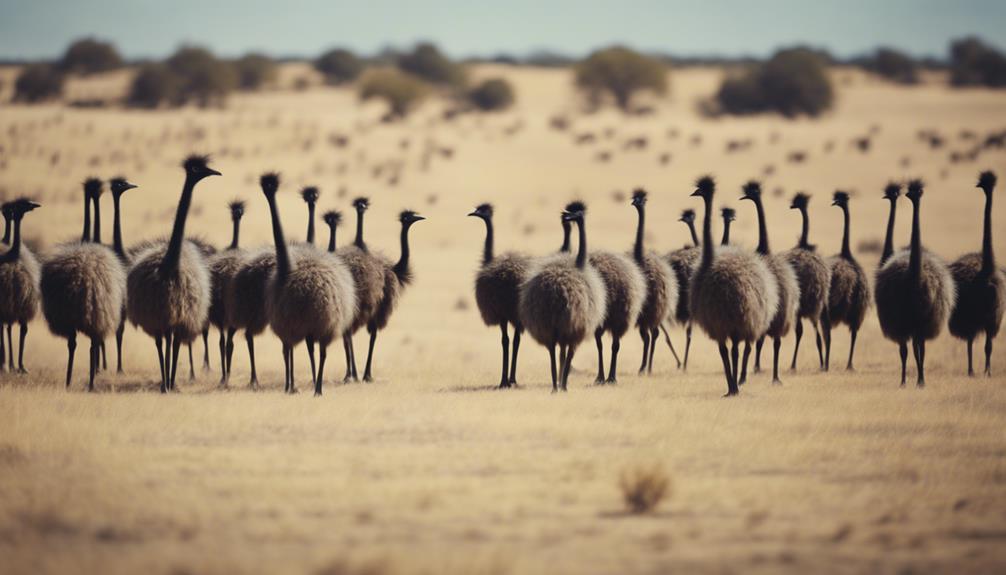
Throughout history, humans have shared a complex and evolving relationship with emus, shaping both cultures in profound ways. The interaction between humans and emus dates back centuries, with emus being a vital part of indigenous Australian cultures. These majestic birds have been a source of food, clothing, and artistic inspiration for various tribes, symbolizing resilience and adaptability in the harsh Australian landscape. Emus were revered for their speed and agility, traits that were admired and sometimes even emulated by humans.
As settlers arrived in Australia, their interactions with emus took on a different tone. Emus were often seen as a nuisance, competing with livestock for resources and damaging crops. This led to conflicts where emus were hunted in large numbers, sometimes resulting in culls to protect agricultural interests. Despite these challenges, emus have persisted in the Australian landscape, serving as a reminder of the complexities of human-wildlife interactions throughout history.
Emus' Behavior Towards Humans
Emus exhibit varying behaviors towards humans, influenced by factors such as proximity, familiarity, and environmental conditions. When humans approach emus in their natural habitat, the birds may display a cautious yet curious demeanor. They often maintain a safe distance, observing your movements with keen interest. In situations where emus are accustomed to human presence, such as in captivity or frequently visited areas, they might exhibit more comfort and even approach humans in search of food or interaction.
However, it's crucial to note that emus can also become defensive or aggressive towards humans, particularly if they feel threatened or if their personal space is invaded. In such instances, they may exhibit behaviors like hissing, kicking, or fluffing up their feathers as a warning. Environmental factors such as noise levels, crowd size, and time of day can further influence how emus interact with humans. Understanding these behavioral cues is essential for fostering positive interactions with these majestic birds.
Human Encounters in the Wild
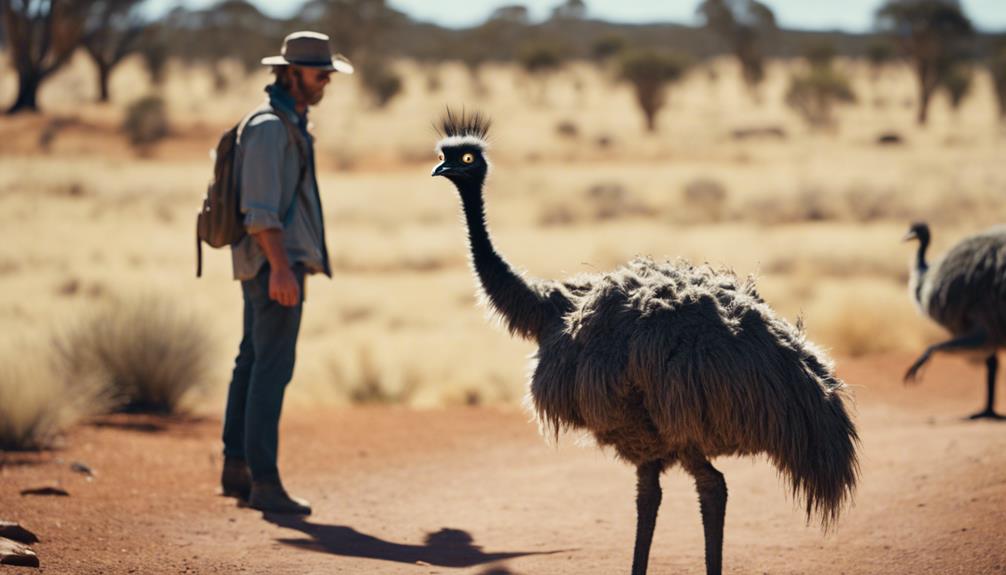
When encountering emus in the wild, your approach and behavior can significantly impact the birds' reactions and interactions with you. Emus are wild creatures that possess a keen sense of awareness and can be easily startled by sudden movements or loud noises. To establish a successful interaction, it's crucial to maintain a calm and composed demeanor. Avoid making abrupt gestures or loud sounds that may trigger a defensive response from the emus.
When approaching emus in their natural habitat, it's essential to respect their space and observe them from a reasonable distance. This demonstrates a level of understanding and consideration for their environment. Emus are known to be curious animals, and by allowing them to approach you on their terms, you can foster a more positive and engaging interaction.
Remember that emus are wild animals and should be treated with caution and respect. By approaching them with mindfulness and awareness of their behavior, you can create a harmonious encounter that benefits both you and the emus.
Emus in Urban Environments
In urban environments, the presence of emus can pose unique challenges for both the birds and human residents. Emus, with their large size and curious nature, may venture into urban areas in search of food or shelter, leading to potential conflicts with humans. These interactions can be disruptive and even dangerous, as emus may cause damage to property or pose risks to public safety.
Urban environments lack the natural resources and open spaces that emus require for their normal behavior. As a result, these birds may struggle to find suitable food sources and safe resting areas, leading them to roam into residential or commercial areas. This can create tensions between emus and humans, as the birds may exhibit unpredictable behaviors when feeling threatened or cornered.
To mitigate these challenges, urban planners and wildlife authorities must develop strategies to manage emu populations in urban areas effectively. This may involve implementing measures to deter emus from entering urban spaces, such as installing barriers or providing alternative habitats for the birds. By addressing these issues proactively, both emus and human residents can coexist harmoniously in urban environments.
Emus in Captivity
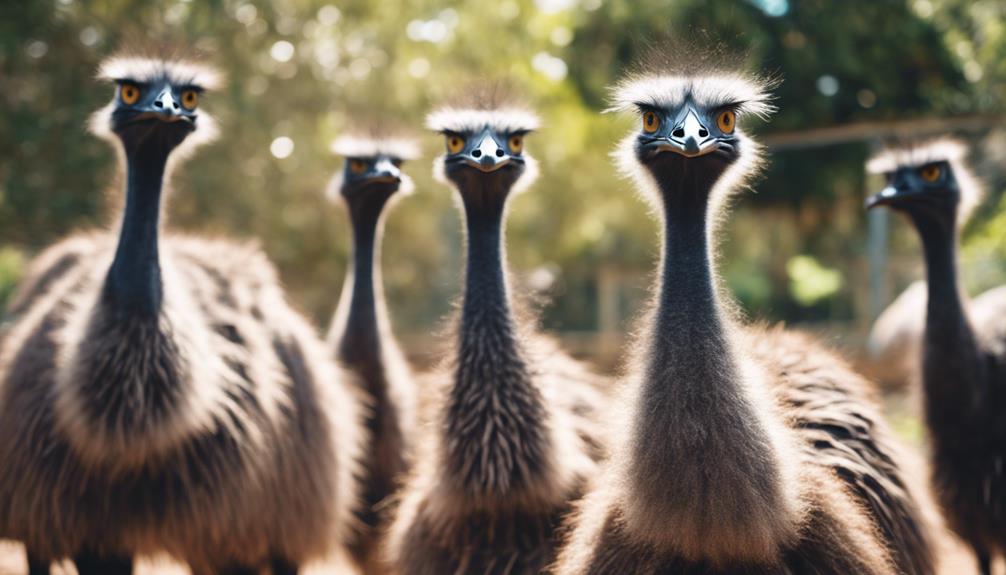
Amidst the controlled environments of captivity, the behavior and well-being of emus can offer valuable insights into their adaptability and social dynamics. When emus are kept in captivity, their interactions with each other and with the environment can reveal essential information about their social structure and hierarchy. Observing emus in captivity allows for a closer examination of their communication patterns, such as vocalizations and body language, shedding light on their complex social behaviors.
In captivity, emus also demonstrate their ability to adapt to new surroundings and routines. They showcase their intelligence by learning to navigate artificial structures and respond to human caregivers. Understanding how emus adjust to captive environments is crucial for ensuring their welfare and facilitating successful breeding programs.
Furthermore, studying emus in captivity provides valuable data for conservation efforts and research initiatives. By closely monitoring their behavior and responses to various stimuli, researchers can gain insights into emus' cognitive abilities and emotional well-being. Overall, observing emus in captivity offers a unique perspective on these fascinating creatures and their capacity to thrive in controlled settings.
Human Interaction Challenges
Navigating the complexities of human interaction poses unique challenges for emus in captivity, requiring a delicate balance between their natural instincts and human care protocols. Emus, with their keen awareness and sensitivity, can find it challenging to adapt to the presence of humans in their environment. When faced with inconsistent behavior or unpredictable movements from humans, emus may exhibit signs of stress or discomfort, impacting their overall well-being.
Establishing trust between emus and humans is fundamental but can be hindered by misunderstandings. Emus, as highly perceptive animals, can easily pick up on human emotions and intentions. Therefore, approaching them with a calm and confident demeanor is essential to fostering positive interactions.
Furthermore, emus have their own social hierarchy and communication methods, which may not align with human expectations. This disconnect can lead to misunderstandings and potential conflicts, requiring careful observation and understanding to navigate effectively.
Benefits of Emu-Human Interaction
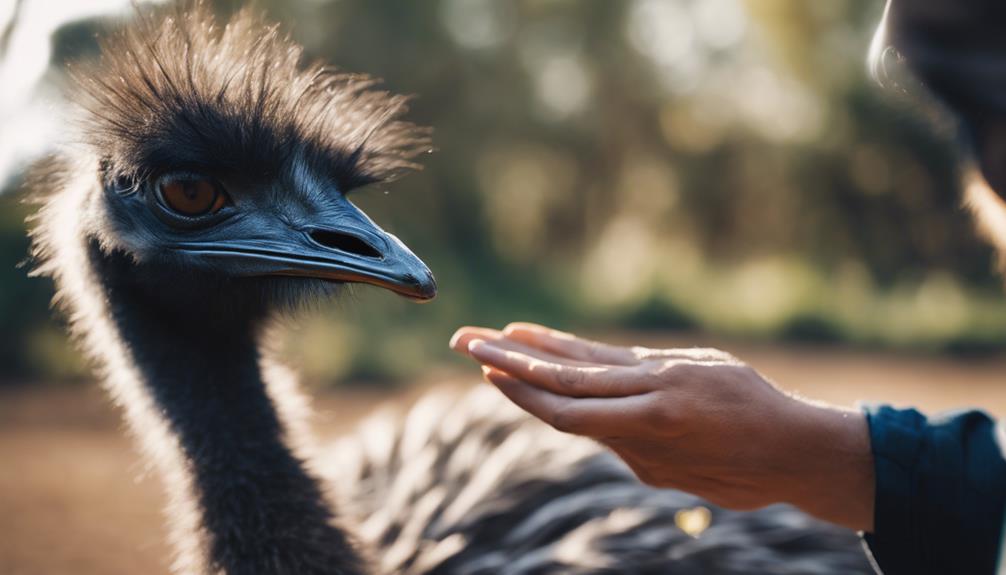
Emus and humans engaging in positive interactions can mutually benefit from increased understanding and enriched social bonds. When humans take the time to interact with emus in a respectful and positive manner, both parties can experience several advantages:
- Educational Insights: Interacting with emus allows humans to observe their behavior up close, gaining valuable insights into their social dynamics, communication methods, and overall lifestyle. This firsthand experience can deepen your knowledge of these fascinating creatures.
- Emotional Connection: Building a bond with an emu can evoke feelings of empathy, compassion, and joy. These emotional connections can be fulfilling and enriching, enhancing your overall well-being and sense of connection to the natural world.
- Increased Awareness: Positive interactions with emus can raise awareness about conservation efforts, habitat protection, and the importance of respecting wildlife. By fostering a relationship with these birds, you can become a more informed advocate for their welfare and the preservation of their natural habitats.
Emus as Tourist Attractions
Tourists visiting certain destinations can often find emus featured prominently as captivating attractions, drawing attention with their distinctive appearance and intriguing behaviors. These majestic birds, with their towering height and striking plumage, possess a commanding presence that demands admiration. When encountering emus in a tourist setting, one can't help but be enthralled by their grace and agility as they move about with a sense of purpose.
Emus as tourist attractions offer a unique opportunity for visitors to witness these creatures up close, providing a rare chance to observe their natural behaviors in a controlled environment. From their curious pecking habits to their impressive speed, emus never fail to leave a lasting impression on those who encounter them. The allure of interacting with such powerful and enigmatic creatures adds an element of excitement to any tourist experience.
Incorporating emus into tourist attractions not only serves as a draw for visitors but also raises awareness about these fascinating birds and the importance of preserving their habitats. As tourists engage with emus, they gain a newfound appreciation for the natural world and the wonders it holds.
Emu Conservation Efforts
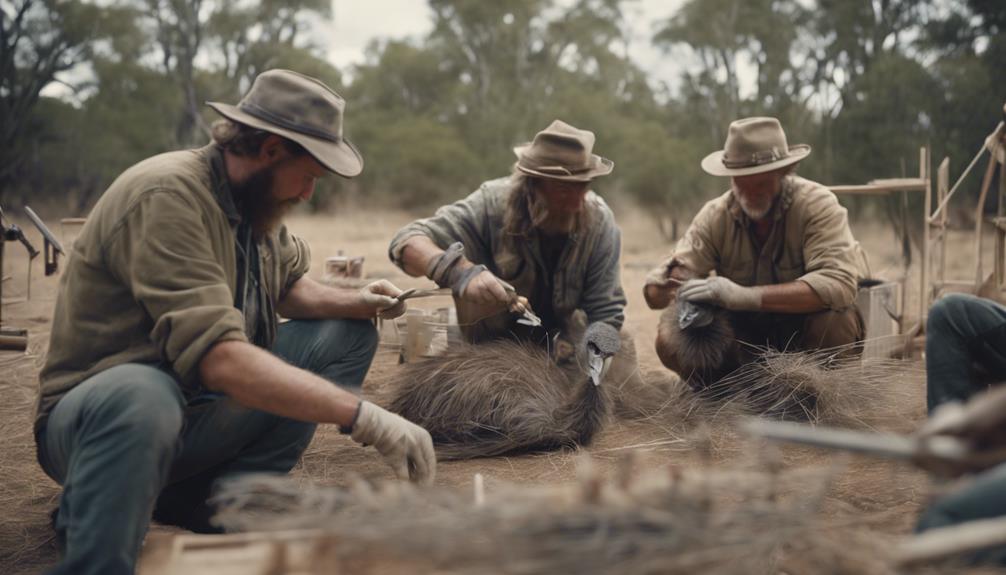
In the realm of wildlife conservation, efforts to protect and preserve the emu population have become increasingly vital in recent years. Emus, as majestic and unique creatures, require focused attention to ensure their survival for future generations.
- Habitat Preservation: Emus thrive in specific environments, and preserving these habitats is crucial. Conservationists work tirelessly to safeguard the natural habitats where emus live, ensuring they've ample space to roam and thrive.
- Genetic Diversity: Maintaining genetic diversity within the emu population is essential for their long-term survival. Conservation efforts often include genetic management programs to prevent inbreeding and promote healthy breeding practices.
- Community Engagement: Engaging local communities in conservation efforts is paramount. Educating the public about the importance of emus in the ecosystem and seeking their support in conservation initiatives helps create a sense of shared responsibility for protecting these magnificent birds.
Emus in Agriculture
With a long history intertwined with human agricultural practices, the role of emus in agriculture has been a subject of growing interest and study. Emus, with their adaptability and efficiency, have been both beneficial and challenging for farmers. Below is a table that outlines the key aspects of emus in agriculture:
| Aspect | Description |
|---|---|
| Pest Control | Emus consume insects and rodents, aiding in pest management on farms. |
| Land Fertilization | Emus produce nitrogen-rich droppings, which can enhance soil fertility. |
| Crop Damage | However, emus can also cause damage to crops by trampling or pecking. |
| Weed Control | Emus are known to eat a variety of weeds, providing natural weed control. |
| Fence Challenges | Their ability to jump high fences can be a challenge for containment. |
Understanding the dual nature of emus in agriculture is essential for farmers looking to leverage the benefits while mitigating potential drawbacks. Emus can be powerful allies in maintaining a balanced ecosystem within farming environments, but proper management is key to harnessing their full potential.
Cultural Significance of Emus

Emus have held a significant place in the cultural heritage of various societies, symbolizing resilience and adaptability in the face of challenging environments. Their cultural significance is deeply rooted in the following ways:
- Symbol of Strength: Emus are often seen as symbols of strength and endurance due to their ability to survive in harsh conditions. This resilience has made them emblematic of overcoming obstacles and persevering through adversity.
- Connection to Indigenous Cultures: In many indigenous Australian cultures, emus are revered for their resourcefulness and are featured in various creation stories and art forms. They hold a spiritual significance and are considered teachers of survival skills.
- Representation of Freedom: Emus, with their powerful legs and ability to run fast, are often associated with freedom and independence. They embody the idea of breaking free from limitations and forging one's path towards success.
Through these cultural lenses, emus have become powerful symbols that resonate with societies across the globe, inspiring individuals to face challenges with resilience and determination.
Future of Emus and Humans
Looking ahead, the partnership between humans and emus is poised to evolve in response to changing environmental dynamics and societal demands. As climate change continues to impact ecosystems worldwide, the future of emus and humans will likely be characterized by a need for sustainable coexistence. Emus, with their resilience to harsh conditions, may become even more valuable to humans as potential allies in adapting to environmental challenges.
Furthermore, advancements in technology and research may offer new opportunities for enhancing this partnership. For instance, innovative tracking methods could provide valuable insights into emu behavior and migration patterns, allowing for more informed conservation efforts. Additionally, genetic studies might uncover new information about emus' unique traits, leading to potential breakthroughs in medicine or agriculture.
In the face of these changes, it will be essential for humans to approach their interactions with emus thoughtfully and responsibly. By fostering mutual respect and understanding, the future holds the promise of a harmonious and mutually beneficial relationship between humans and emus.
Frequently Asked Questions
Can Emus Be Kept as Pets in a Residential Setting?
You can keep emus as pets in a residential setting, but it requires ample space, secure fencing, proper diet, and understanding their social behavior. Emus are large, curious birds that need careful handling and respect.
What Are the Risks of Feeding Emus in the Wild?
Feeding emus in the wild poses potential perils. Predators may be attracted, disrupting their natural habits. Emus might become reliant, losing hunting skills. Competition can arise, altering ecosystem dynamics. Proceed cautiously to prevent problems.
Are There Any Documented Cases of Emus Attacking Humans?
Yes, there have been documented cases of emus attacking humans. These incidents typically occur when humans invade the emus' territory or provoke them. Understanding emu behavior and respecting their space is crucial to avoid confrontations.
How Do Emus Communicate With Each Other and With Humans?
Emus communicate by emitting low-frequency calls and using body language to convey emotions and intentions. They may approach humans out of curiosity or to establish dominance. Understanding their signals can help prevent misunderstandings and promote safe interactions.
What Are the Regulations Around Owning Emus in Different Countries?
Regulations around owning emus vary by country. Familiarize yourself with local laws and permits. Owning and caring for emus responsibly ensures compliance and the well-being of these unique birds. Stay informed and follow guidelines diligently.
Conclusion
In conclusion, as you reflect on the intricate dance between emus and humans, you see a tapestry woven with threads of curiosity, respect, and resilience. Like a delicate balance of nature's forces, the relationship between these fascinating birds and us is a testament to the enduring connection between species.
As you ponder the future of emus and humans, remember the lessons learned from their interactions, guiding us towards a harmonious coexistence in the ever-changing world.




